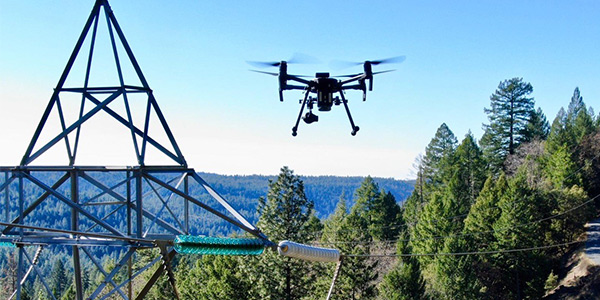Rapid advances in digital technology can provide utilities with much needed assistance in wildfire response, panelists said during Edison Electric Institute’s 2020 Virtual Leadership Summit.
In the “Harnessing Technology to Fight Wildfires” panel, attendees including Caroline Winn, CEO of San Diego Gas & Electric, discussed the potential of emerging technologies such as drones and cloud computing to record and correlate information at speeds far beyond that of human operators. This can be especially important in California, where the increasingly warm and dry climate means that wildfires have been a major threat to the power grid. (See WECC Tackles Wildfires as Reliability Threat.)
“Drones are giving us a different viewpoint of our infrastructure and really provide us a higher level of granularity than inspections done on the ground or [from a] helicopter,” Winn said. “We’re now implementing machine-learning models to automatically detect images coming in from our drone program, and that’s complementing and additive to our weather prediction models.”
Beyond preventing and detecting wildfires, technology also plays a vital role in SDG&E’s strategy for mitigating the impact of fire-related public safety power shutoffs (PSPS). One aspect of this strategy is the creation of microgrids in designated areas, using small solar generation resources in conjunction with battery storage to keep electrical equipment in these regions operating in the event of a larger grid failure. SDG&E has four microgrids: two in low-income communities, one for a major medical care facility and one for an air traffic hub used by firefighters in Southern California.
Caroline Narich, managing director at Accenture — a professional services company that partnered with SDG&E to implement its cloud analytics platform, as well as other technology-enabled services — said the company’s system optimization software presents further possibilities for mitigation of harm. System optimization in this sense refers to the representation of every physical asset in cyberspace via a “digital twin” that can be used to train automated grid management software via machine learning.
“If we apply this to wildfire management, we can envision a world where we’re better able to manage the system as we go into these wildfire events,” Narich said, “for example, by communicating directly to the microgrids or to the local batteries, telling them to preserve power and then actually leveraging that capacity to minimize the impact of the PSPS event.”
Another potential application of cloud technology suggested by Narich is in customer engagement. Utilities may already use mobile apps to communicate with customers during wildfire events; these can be expanded to include targeted notifications to those in the highest-risk regions, as well as through visualizations of outage data and real-time photographic imagery of affected areas.
Panelists acknowledged that making full use of these emerging technologies will require careful tuning to ensure safe implementation. Responding to Winn’s comments on drones, Everette C. Rochon Jr., acting manager of the Federal Aviation Administration’s General Aviation and Commercial Division, pointed out that rules regarding unmanned aerial vehicles are still in the very early stages and warned that utilities should be conservative as they move forward with their introduction.
“[We call it] the three A’s: airmen, aircraft and airspace,” Rochon said. “Manned aircraft operations have established standards and processes in all three areas, [but] these are not well established in the unmanned world, and they have to be considered concurrently and at the speed of innovation.”






